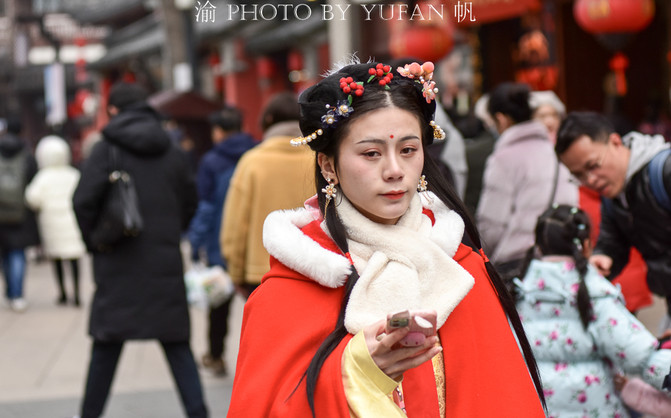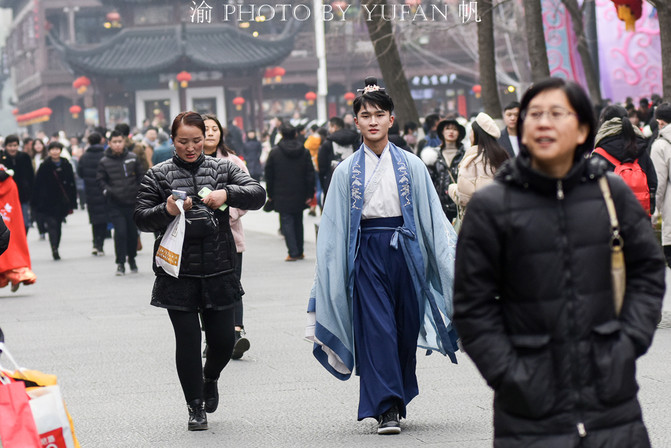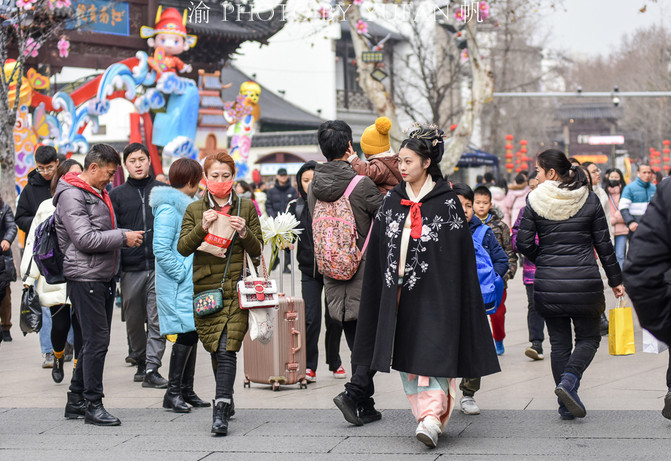Wearing ancient costumes to visit the ancient city in Nanjing has become increasingly fashionable. Young men and women take advantage of it and demonstrate cultural confidence

On the eve of the Spring Festival, Yu Fan and several friends traveled in the ancient capital of Nanjing, focusing on visiting many tourist attractions in the Confucius Temple-Qinhuai River Scenic Belt, such as Confucius Temple, Zhanyuan, Bailu Island, Qinhuai River, Ming City Wall, Da Baoen Temple, Jiangnan Gongyuan, Zhanyuan, etc. This is Nanjing's traditional Laocheng District with a long history and rich culture. It integrates natural scenery, street houses, landscape gardens, local customs, temples and schools, food shopping, popular science education, festival culture and other landscapes. It is China's famous open national 5A-level tourist attraction and the top 40 tourist attractions in China.

In this area, there are many well-known landscapes across the country, such as Nanjing's mother river and the cradle of ancient civilization-Qinhuai River. It is known as "the smoky and moon area of the Six Dynasties, where gold powder gathers" and is also a prosperous place for ten generations. It is called "China's first historical and cultural river" because of its "clothes and cultural relics, which are prosperous in the south of the Yangtze River; its literary talent and romantic style are the best in the sea."

In addition, Nanjing's Confucius Temple is also well-known across the country as one of the four major Confucian temples in China. It is on the same footing as Qufu Confucian Temple and Beijing Confucian Temple. It is the cultural hub of ancient Jiangnan in China and a gathering place of historical humanities in Jinling. It is not only the cultural and educational center of Nanjing during the Ming and Qing Dynasties. It is also the cultural and educational building complex ranked first among the southeastern provinces and the largest traditional ancient market in China.

Not only can you read Nanjing's history and culture here, but you can also take a cruise ship to shuttle through the Qinhuai River to experience Du Mu's "smoke cage, cold water, and sand cage, and stay at Qinhuai near restaurants at night. The merchant girl didn't know the hatred of the country's subjugation. She still sang "The flower in the back court, Liu Yuxi" across the river, and the grass and flowers beside the rosefinch bridge, and the sunset at the entrance of Wuyi Alley. In the old days, Wang Xie Tang and Yan Yan flew into the homes of ordinary people "... and many other famous poems left here by many literati and literati.

During our visit to the Qinhuai scenery belt of Confucius Temple, we were deeply impressed by the rich culture, long-established history, tempting food, as well as the ancient costumes (or Hanfu) that can be seen everywhere. People in other places wear Hanfu to take photos. Nanjing people in the area of Confucius Temple seem to wear Hanfu as a kind of enjoyment. Wearing this kind of clothing makes them feel comfortable.

The so-called Han costumes are not the costumes of the Han Dynasty, but the traditional national costumes of the Han nationality, also known as Han costumes and Chinese costumes. It mainly refers to the unique Chinese nation formed through natural evolution in the nearly 4000 years from about the 21st century BC to the middle of the 17th century AD (late Ming and early Qing Dynasties), based on the national culture of China (also known as the Han nation after the Han Dynasty) and formed through natural evolution. The style and character are different from the traditional costumes of other nations; or: "Han Traditional Costume" is the general term for a series of Chinese (Han) national costumes with strong Chinese (Han) national style, written by the Chinese (Han) nation from the Xia, Shang and Zhou Dynasties to the Ming Dynasty.

Hanfu is one of the oldest national costumes in the world. According to the Records of the Historian, clothes in China were made by the Yellow Emperor."Before the Yellow Emperor, there were no clothes houses. When the Yellow Emperor built houses, made clothes, and conducted funerals, the people were spared the difficulty of survival." ("Records of the Historian, Volume 1, the First of the Five Emperors 'Chronicles) About 5,000 years ago, during the Yangshao Culture period of the Neolithic Age, China developed primitive agriculture and textile industries. It began to use woven linen to make clothes, and later invented silkworm feeding and silk spinning, and people's clothes and costumes became increasingly complete.

Han costumes have not changed much since the Zhou Dynasty to the Ming and Qing Dynasties. The basic characteristics of Han costumes have not changed significantly for more than 3,000 years. In the Yellow Emperor's era, crowns appeared, and the clothing system gradually took shape. After the Xia and Shang Dynasties, the crown and clothing system was initially established, and gradually completed during the Western Zhou Dynasty. In the late Zhou Dynasty, due to the drastic changes in politics, economy, ideology and culture, especially the hundreds of theories that had a certain influence on the improvement of clothing, the clothes, costumes, customs and habits among the vassal states began to have obvious differences. and create deep clothes. The crown and clothing system was included in the scope of "etiquette rule" and became a form of expression of etiquette. From then on, the crown and clothing system in China has become more detailed. It was not until the modern Western civilization had an increasing influence on our country that Hanfu gradually withdrew from the historical stage.

With the continuous development of our country's economy, people have gradually realized that what is the nation is the world. While increasing the protection and inheritance of ethnic minority cultures, the excavation and inheritance of Han culture have also increased efforts. Many people have begun to appear in Hanfu communities and circles. Everyone enjoys Hanfu and enjoys the joy of returning that culture. As a result, Hanfu craze has gradually formed throughout the country.

This phenomenon of Hanfu craze is particularly obvious in the Qinhuai River scenery of Confucius Temple in Nanjing. They feel that wearing ancient costumes and visiting the ancient capital will be more charming. The thick blue bricks, rolling city walls, and spectacular towers complement the gorgeous Hanfu. According to one of the beautiful women wearing palace costumes, she has five sets of ancient costumes in her home. Every weekend, she will take off her overalls, change into Hanfu clothes, and meet friends to visit the Qinhuai River of Confucius Temple. Looking for delicious food and taking beautiful photos together. Enjoy this eye-catching Hanfu life together. There are many young men and women like her. Everyone wears Hanfu as ordinary clothes, not for festivals or activities, but for their own fun. It has become an indispensable part of their lives. In Yu Fan's view, this craze for Hanfu is also a concrete manifestation of cultural confidence.
Previous Article:Nanjing, Jiangsu: You can obviously rely on Internet celebrities to make headlines, but you rely on strength to speak!
Next Article:Nanjing's largest high-altitude restaurant features a theater-style kitchen and overlooks the city's streetscape!
